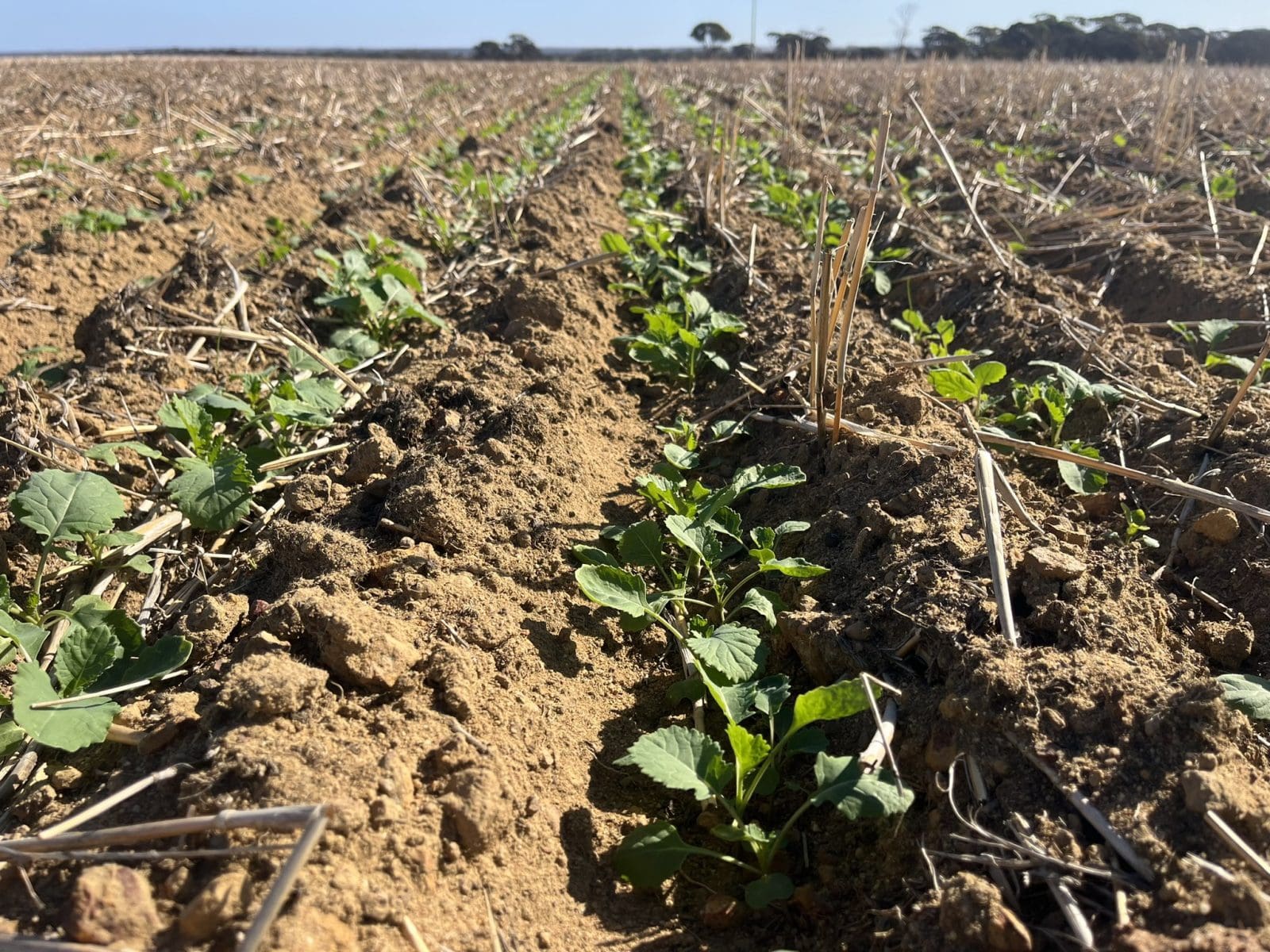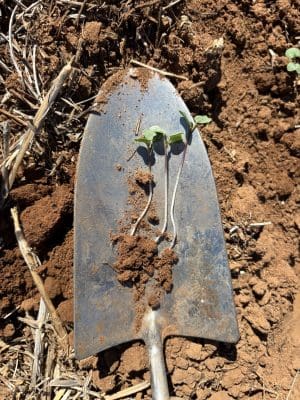
A crop of canola last week planted after good rain in Western Australia’s Varley region. Photo: Kurt McPhee
ESTIMATES for Australia’s major crops have started to appear ahead of opening new-crop figures due from national forecaster ABARES on 3 June.
Looking at estimates from three bodies – Rural Bank’s Australian Crop Forecasters, Lachstock Consulting, and the USDA – Lachstock’s wheat figure at 33.26 million tonnes (Mt) is 9 percent above the lowest, 30.19Mt from ACF.
On barley, Lachstock’s 13.4Mt tops the estimates, 7pc above ACF as the lowest on 12.43Mt, while on canola, USDA at the top on 6.15Mt is 14pc above Lachstock on the lowest estimate of 5.3Mt, revised down from 5.56Mt seen in March.
Concerns about dry conditions in southern New South Wales, the powerhouse of eastern Australia’s canola production, South Australia, and Victoria, account largely for the greater difference in canola estimates.
“Weather in Australia remains a key focus for the canola market,” Lachstock said in its most recent canola supply-and-demand report issued April 24.
“It has been overly dry for the eastern states in particular and we are seeing area switch out of canola and into wheat and barley.
“The higher cost of production, wider GM spreads in recent years and now low soil moisture are causing farmers to take a cautious approach and move away from canola.
History says rain in June can kick off average or better cereal, canola and pulse crops for southern Australia, providing winter brings regular falls, and spring is kind.
Bringing hope for rain is the Bureau of Meteorology forecast for at least 10mm of rain across the dry grain-growing areas of Vic and NSW, and the southern reaches of SA’s cropping zone.
Australia’s winter crop is estimated to be at least two-thirds sown, with vast areas of wheat and chickpeas in Queensland and northern NSW, where conditions are good to ideal, yet to go in.
| Wheat | Barley | Canola | |
| ACF | 30.19 | 12.43 | 5.36 |
| Lachstock | 33.26 | 13.4 | 5.3 |
| USDA | 31.0 | 12.5 | 6.15 |
Table 1: Latest estimates in million tonnes for Australia’s three major winter crops in 2025-26 from ACF, Lachstock Consulting, and the USDA.
Growers press on with sowing
At Horsham in Victoria, Matthew Sparke said sowing has advanced at pace, despite the dry conditions.
“Some guys are nearly finished, and it’s going to move along pretty quick now because there might be 10mm or so in Horsham from this weekend,” Mr Sparke said.
He said germination has been patchy in those crops which have received small amounts of rain in recent weeks, and some resowing may be required.
“Canola may be at the six-leaf and the cotyledon stage in the one paddock, and that’s going to make it hard for early weed control.”

A number of growers in Vic and southern NSW have planted canola deeper than normal to access subsoil moisture. Photo: Matt Witney, Dodgshun Medlin Swan Hill
He said some clients have dropped canola paddocks, or “dropped the lot” out of the rotation, but most are sticking with the entirety or majority of intended canola area.
“Some has been sandblasted and needs to be resown, but I’d say 70pc is still there.”
Mr Sparke said barley was likely to make a late gain in area at the expense of canola, generally the first cash crop to be sown from mid-April.
Sefton Agronomics principal Greg Sefton is based at Barooga on the Vic-NSW border, and said most crops have been sown dry and were yet to germinate.
The exception is irrigation, which accounts for roughly 10-15pc of area, where wheat and canola has gone into pre-watered ground and is up and away, and dryland area will germinate if rain forecast for the weekend delivers.
Mr Sefton said crops will be starting with generally no subsoil moisture, and the first light frost of the season settled on Tuesday morning.
“If we get a break this weekend, we’ll be in the window for the majority of our wheat, and we’ll be relying on rain over winter and spring,” Mr Sefton said.
Crops established on irrigation country are having urea applied this week at around 150kg/ha.
“No urea’s going in with dry-sown; they’ll let this rain go through, and it will go on in the next two or three weeks.”
Mr Sefton said small areas of failed crop would be resown, mostly north of Finley and Berrigan.
“There is some resowing of canola to barley on dryland due to the false break, where 5-10mm fell on heavy soil, and canola shot and died.
“They’re not spraying canola out; some will come up when it rains, and we’ll spray it in-crop.”
At Wagga Wagga, Riverina Independent Agronomy senior agronomist Neil Durning said most crops were planted, or were being planted, and early-sown canola has established if it was sown at depth.
Canola is normally sown at 25-30mm, and Mr Durning said those who have been brave enough to chase moisture to 50mm or so have been rewarded.
“They’re not quite up to groundcover stage, but they’re close,” Mr Durning said.
Germination through moisture sitting at a depth of 50-75mm, instead of in topsoil, means canola has not grown enough to allow sheep on to it this autumn.
“We won’t get to graze it this year, and there won’t be many dual-purpose crops in 2025.
“Anything up will have significant vigour reduction through going through this much stress.”
Mr Durning said barley has already cribbed some area from canola.
SA growers ‘really nervous’
After a very low-rainfall growing season last year, Grain Producers SA reports its members were cautiously pushing ahead with seeding, with many adjusting inputs and delaying sowing in the hope of rain.
GPSA’s 2025 Seeding Intentions Survey drew responses from 171 growers, and responses released this week indicated 64pc of them had not started seeding prior to the historically suggested season break of Anzac Day, citing the lack of opening rains as the major reason.
Only 14pc had started seeding by Anzac Day week, with a further 22pc sowing prior to that.
GPSA chief executive officer Brad Perry said the survey results highlight a season being shaped by moisture stress and financial risk.
“Grain producers are being forced to make some incredibly tough decisions this season, with many delaying sowing due to a lack of soil moisture, and others dry seeding significant areas just to stay on schedule, hoping for imminent rain,” Mr Perry said.
“This survey tells us that growers are adapting, but the uncertainty is weighing heavily on farm confidence during the drought.”
The average confidence rating for the season ahead in the survey was four out of 10, with some grain producers rating their outlook as low as zero.
The survey showed 92pc of respondents were planting wheat, 87pc barley, 56pc lentils, 34pc canola, and 30pc faba beans.
More than 70pc of producers said they would dry sow at least some of their crop, with 15pc intending to dry sow everything and 14pc stating they will not dry sow at all.
While many producers are experienced in dry sowing, confidence this season is notably lower.
Only 17pc of respondents said they were very confident in the success of dry sowing under current conditions, while 31pc said they were not confident at all.
“This is not just another dry year—it’s the compounding impact of successive difficult seasons.
“Some grain producers are walking a tightrope, trying to keep costs in check without knowing whether the season will turn in their favour.”
Input costs remain a key concern, with almost 50pc of growers in the survey reducing fertiliser usage in response to the dry conditions, while 45pc are proceeding unchanged.
Many are basing fertiliser adjustments on soil testing, rotation planning, and low nutrient removal from failed 2024 crops.
“Growers are being forced to take a more conservative approach to fertiliser and other inputs.
“With margins tight and moisture scarce, it’s about managing risk while still being ready if the season improves.”
Grain Central: Get our free news straight to your inbox – Click here


HAVE YOUR SAY